Intel X25-V 40gig Value SSD Review/Building a Composition Step by Step

|
• Grand View Hotel Chang Hua • Howard Lake Resort Shihmen Dam • Forte Dong Shan Villa Hotel Lugang • Leader Landmark Hotel Lugang |
Thank you for your generous contributions. At the present time we have enough images to attempt our first mosaics but these are very time intensive and I'll need to plan a block of time to do these properly. I'm thinking the last few weeks in
May or the first two weeks in July. June didn't work out. Until then, any images you can manage to send in will still be used and will be much appreciated.
We are still accepting (and pleading for) images of children from SEA. No matter how terrible you think they are, please send them in anyway. These images will be used to complete a set of 3 high quality mosaics which will be sold to benefit the Karen and Burmese Orphans living in the orphanages and refugee camps. The more images the better, I can use all you have. Please take the time to go through your images for anything you think might help. If you missed the "No Place to Call Home" special, you can click on the link and read more about this. Thank you! info@BangkokImages.com
Quick Click Links
Feature Photograph
Intel X25-V Value SSD, review Building a Composition, Step by Step
Photography News of Interest
Readers Submissions
Readers Questions A Snapshot of Bangkok Images Week in Review
Infocus Blog, I'm Troubled
Feature Photograph *menu
This week Tom Tweedel will be presenting the Feature Photograph. He's been wanting to write a Feature Photograph article for some time and this is his first attempt. I encourage you to provide constructive feedback to Tom Tweedel via email.

Nikon D300, Nikkor 18-200mm VR @F7.1 1/500th 18mm ISO 400
The photo was taken at a lion dance at a Chinese New Year celebration in Austin. This photo “works” on many levels, and illustrates several concepts and flaws of successful composition.
The first thing that is really working here is the focal length, 18mm on a crop camera, 27mm equivalent on a full frame. The wide angle in this case is not really used to “get it all in” but
to get up close. The perspective effect of a wide angle lens emphasizes the foreground at the expense of the middle to background. It makes close up object larger than life (in this case the Lion and the Boy).
Next we have the compositional element of lines. Lines are very powerful compositional elements, especially when people are involved. They imply connections which give a photo more feeling. In this case there is a strong connection formed by the Lion
facing the boy and the boy looking at the lion with a hint of a smile. In addition the blue lion was also looking at the boy from over the shoulder of the rainbow lion. This connects both the foreground and the middle ground.
The angle the shot was taken at was critical to the composition. It’s important to remember that not everything looks its best from 6 feet above the ground. Bringing the camera down to the level of the boys head allows the lines of connection to
really play out since they almost connect with the camera itself due to the position. If I had just stood there and taken the shot standing up it would not have been as powerful.
Color is a strong compositional element. The color of the rainbow lion is complex an interesting, it breaks up the detail allowing you to study each of the facets of the costume. The red in the head also ties to the red in the boys outfit. The colors
of the blue and green lion also draw our attention away from the less “successful” compositional elements.
The background is a mixed back. The sign above and to the left of the lion is useful in that it places the location of the photo for those familiar with the area. There is also a lot going on in the background as one would expect in a festival. The little
girl pulling her brother is a nice touch. The trees on the right tend to give balance. The bucket is a minor annoyance, not something your likely to notice in the moment though.
One compositional flaw that illustrates the concept is depth of field (or lack thereof). One of the challenges with close up photography is getting enough depth of field to have your foreground to background
in focus. In this case the boy's head is slightly out of focus. This is because the focus point was on the Lion (should have been the boys head). Things move fast and there isn’t always time
to get the right sensor selected or to focus and recompose.
The relatively low F-stop (F7.1) contributed to the problem. There was enough light to go F11 or greater. Using a higher F-stop would have given more depth of field. But at the time I was more concerned
about getting a high shutter speed to capture other elements of the dance (specifically the explosions of the firecrackers). This was also the reason I was going at ISO 400 vs. a more optimal 200. The high
shutter speed does add to the photo in that the “beard” is frozen in the up position, though 1/250th would have been acceptable.
A lot of compositional elements went into making this a great picture, more than you’re likely to have time to think about each time before you push the shutter. But with study and practice more and more of them will become automatic and you’ll
find yourself taking better pictures without thinking about it.
Intel X25-V SSD, Review *menu
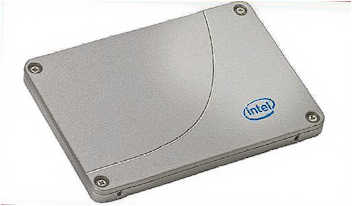
Introduction
At Bangkok Images we've become a big believer in Solid State Drives (SSD). Every application where we add an SSD the total character of the machine changes, in every case a dramatic change that makes
your 3-4 year old laptop feel like the latest speediest model out there.
Intel recently came out with their value line of SSD's and their X25-V is a 2.5" 40gb SSD running roughly $90 USD's through Amazom.com was calling out to us to be tested. My son is visiting and he brought his 3-4 year old Dell Inspiron
1720 notebook. This is a somewhat lower end consumer model with a big bright 17" 1920×1200 screen and a bright white exterior finish that he's stuck stickers all over from his various hobbies and sports. It has a Core 2 Duo 2.16g CPU
with a recent 4gig RAM update and a less recent 320gb 5400rpm HDD upgrade we did a few years ago. He's been mostly happy with the machine, his biggest complaint being the amount of time necessary to boot and of course he'd like his programs
to load faster. His 1720 has the added feature of dual HDD stalls so it could hold two 2.5" HDD devices. Currently one was empty.
Choices
The X25-V isn't Intel's speediest SSD nor does it have the most capacity. This SSD was aimed at the part of the market where the user wanted the performance of a SSD and was willing to work around the capacity issues either by using it as a
system only drive in a desktop workstation, or as the main system drive in a notebook making the use of an external USB powered HDD for data, music, and videos' necessary.. something many of us do anyway. In my sons case his Dell Inspiron
just happened to be one of the few laptops capable of holding 2 hard drives so it was a perfect fit.
What if your laptop doesn't hold a second drive and you don't want to lug around an external just to have an SSD? Take a look at this site,
they make "caddies" that transform your optical drive bay into a hard drive bay allowing you to put your old hard drive in your optical space, and a new SSD into your old HDD bay.. or the other way around. The caddies run from $20-$40.

Cost is obviously a factor. When I bought the (2) Crucial Technologies 256gb C300 SSD's for my main workstation and my primary laptop, and reviewed them here and here, these drives were running an expensive $800 USD's. Since the price has come down to a more reasonable but still expensive $610 and Crucial
has credited my account for the difference. Good companies concerned about good customer service do things like this. So spending $90 (I've seen it for as low as $90 and as much as $129) for the Intel
X25-V 40gb SSD was an easy choice in this case.
Keep in mind that when it comes to reliability Intel is the company to beat making, for my sons needs, the Intel X-25V a perfect fit.
Performance
In my previous SSD reviews I mentioned there is a lot more to a SSD's real life performance than the sequential read and write figures commonly touted to sell SSD's. The numbers that really matter are your 4k access times. Intel designed the
X25-V 40gb SSD to be of primary use to someone using it to load and reload the operating system and system programs and it's tweaked its controller to provide some of the best 4k access times on the market. Both my newLenovo x201s ThinkPad with its expensive $610 256gb Crucial C300 SSD
and my sons 3 year old Dell Inspiron with the $90 Intel X25-V 40g SSD are both using Windows 7 x64 Ultimate, they both have 4gigs of RAM, and we have the same program sets installed on both. Both FEEL the same speed for 90% of our uses. Sure,
the C300 is faster, no doubt, and the benchmarks show it. But in real life use the Intel X25-V 40g SSD is so much faster than a regular HDD that you reach a point where you don't really notice faster.
Where you do notice it, is when you pull data from the older 320gb HDD in his second bay slot and where this same data is on my larger capacity SSD. However, most of the time you're working off the system drive and the difference is negligible if
noticeable at all.
Installation
Installation couldn't be easier. The first thing you'll notice is the Intel SSE comes in a sturdy all aluminum case. The case on the much more expensive Crucial C300 is a cheaper feeling plastic. The brushed aluminum feels 'all business'
and very tough. It's also sealed well. The SATA II power and data connectors are of a very high quality and snaps into the laptop connector solidly.
After copying his data to an external HDD we removed his old 320g HHD and set it aside, and screwed in the new SSD. Booting to a Windows 7 disk we followed the install route until we got to the point where we could partition the drive. At this point we
initiated the drive and assigned all 40g's to a simple volume we named C. Windows 7 x64 Ultimate finished installing less than 7 minutes later.
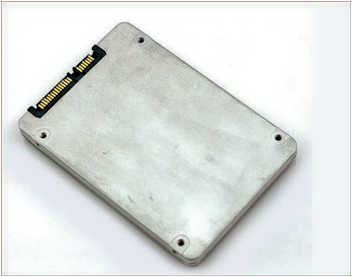
Building a SSD system drive, that is installing and configuring all your programs goes very quickly on a SSD. It took him about 2 hours to install Office Professional, Lightroom, Adobe CS5, and a bunch of misc programs such as browsers, social networking
clients, and the such.. and he was done.
We then put his original 320g HDD into the second HHD bay and booted to the windows disk and used its partition manager to wipe out the old bootable partition, make a new simple volume, and format it for use. 30 minutes later we'd copied his 200g's
of (data) music and videos back over.

Summary
I would be lying to you if I told you there was anything less than a dramatic difference. For a week now he's been telling me in awe "it feels like the fastest computer I've ever used, I can't believe the difference." Yes, that's what a SSD will do for you.
With Intel's great support, 3 year warranty, and low initial price of $90 this was one of the lowest priced performance upgrades possible.. and one that makes sense. If he replaced his old Dell tomorrow he could pull this SSD and it's program
build and easily install it in the new replacement. Of all the upgrades you can make to your laptop, THIS one, installing a SSD, THIS IS THE ONE you want to spend the money for. He now boots from power off in under 8 seconds, shutdown in 2-3 seconds,
and any program loads instantly. It's shock proof, heat proof, draws very low power, and was only $90.. what's not to love?
Building a Composition, Step by Step *menu
Purpose
I often tell students in my workshops that "seeing" your composition is the real skill in photography and it's a skill you can't learn in a day or rush in any way. 'Seeing'
is a great part of defining your personal style. Most people looking at the exact same scene don't 'see' the scene in the same way. Sometimes they notice different elements of the scene others
don't, and sometimes they miss elements others see. And then there's the other compositional elements such as focal range, perspective, exposure, depth of field, and more. It's entirely possible
to make someone a 'technical expert' with the gear with several days of instruction, but you can't rush the creative. If we could then English and writing teachers across the world could teach
us punctuation and sentence structure and we'd all be Hemingway's by the end of the week. Knowing the rules, or how a camera works, is not the 'end all' to the creative process. It merely
allows us to use our instrument of choice (camera) to express our creativity.
This short tutorial will attempt to show you the type of composition most will be shooting as they come into a workshop, and then I'll take you through my own creative thought processes to alter the composition as I would during instruction. Please
keep in mind there are no right answers or single ways of doing things. I might explain one creative process for one scene, and another for a different scene. This is where experience dictates your choices. The more experience you have the more
choices you have available to form your composition.
A Student's Eyes
While looking at the new BTS Skytrain station I asked a young student to explain how they would photograph the scene. Having some experience already he set up his camera on a sturdy tripod to ensure sharpness and make possible longer shutter speeds. It
was an hour before sunset so he set the aperture for a suitable DOF, a working shutter speed (considering the tripod), and an appropriate ISO. Framing the shot he made the exposure.

Canon 5d Mark II, 70-200mm F2.8L IS @F8 1/50th 173mm ISO 400
This is a correct exposure and you can't fault the composition as it includes both the skytrain and the station and you can see both clearly. Sharp, well exposed, and appropriate camera settings. This is what you'd expect from someone who knew
how to use the camera on a technical basis.
I felt there could be more. Actually, I'd already worked out "my" composition, how I would do it, but I wanted this student to come to his own conclusions and discovery. I asked "can you think of a way to include more story telling, or more action, or something more in the composition?" Smiling with confidence I was told he could do that. And he did.

Canon 5d Mark II, 70-200mm F2.8L IS @F8 1/80th 70mm ISO 400
Nice! Now he included a moving train entering the station and a great deal more of the cityscape in the background. By decreasing the focal length to 70mm we can see more of the scene. But I felt there could be more and I said as much. "Push your boundaries" I said, give as much 'impact in the scene as possible. Settling back behind the viewfinder he studied the scene while waiting for the next train to appear.

Canon 5d Mark II, 70-200mm F2.8L IS @F8 1/60th 110mm ISO 400
With a bit of cropping we'd now have a train leaving the station with a mosque for the background. The composition was improving in increments and I was making my own shots through the same set of gear as time allowed. I encouraged more and my student
was up to the challenge. As darkness was falling he made some changes to the ISO and aperture.

Canon 5d Mark II, 70-200mm F2.8L IS @F5.6 1/50th 200mm ISO 800
I Get Involved
Now he was bringing in the Expressway behind the skytrain station and again I couldn't fault his composition but I knew there could be more. By now it was almost dark and he figured the shooting opportunities disappeared with the light, and to be
fair he had reached the limit of his current skill set. In the coming days he'd learn much more, but for now he asked: "Show me what you would do, what you see, and walk me through the process?" I'm glad he asked.
The first thing we must realize is that there are no 'bad' shooting conditions, there are only different shooting opportunities. Darkness can often help make dramatic differences in the same scene.
With darkness comes street lights, car lights, building lights, and today even clouds and lightning!

Canon 5d Mark II, 70-200mm F2.8L IS @F8 1/5th 125mm ISO 800
To start I used panning and shutter drag techniques to impart a feeling of speed. This isn't exactly easy, but you can become competent with a few days' practice. I locked focus on the front of the train with my center AF point and panning horizontally,
and on the tripod for stability, I slowly decreased my shutter speed in increments of 1/2 stop until I had what I saw in my mind. Keep in mind the skytrain is barely traveling 15kph at this point yet it looks like it's going 120kph. Panning
kept the skytrain in focus as it moved and separated it from the background as far as movement was concerned, and dragging the shutter gave me the 'depth' of the desired effect even though
the train was moving slowly. By now it was mostly dark and the lights under the tracks gave off a sort of orange glow.
A nice enough composition, but more like an ad in a brochure than the dramatic image I was envisioning. I made this image as an example of the techniques for my student, otherwise I would have just skipped the opportunity and moved on.

Canon 5d Mark II, 70-200mm F2.8L IS @F20 1.6secs 73mm ISO 800
What I was trying to do from this point was to capture the skytrain, stream the head/tail lights together from the cars on the Expressway, show a nice cityscape, all with lightning in the background! I could have easily used F5.6-8 and ISO 200 but the
quality was there at 800 with a Canon 5d Mark II and this was for illustration only so I only made the three adjustments (aperture, shutter speed, focal length) to save time. There was a bit of lightning
in the background, but no skytrain! I needed both at the same time.
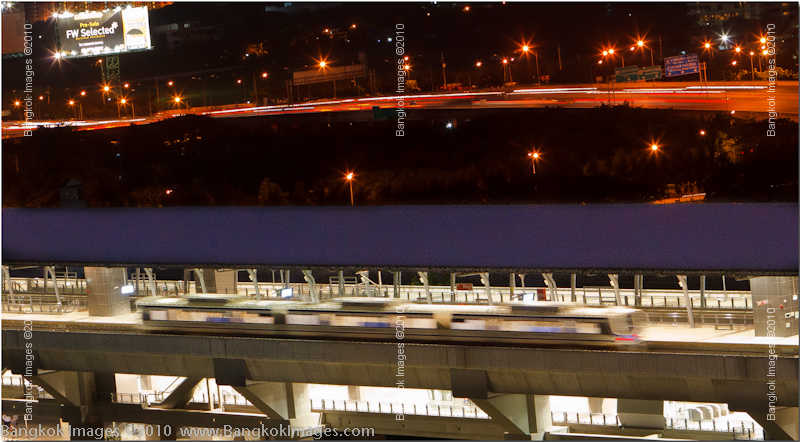
Canon 5d Mark II, 70-200mm F2.8L IS @F8 1.6secs 73mm ISO 800
The darkness increased and still no lightning so for fun I explained how to show both the head/taillights on the Expressway stream together AND show the effect of speed of the train. It's all about balancing the settings.
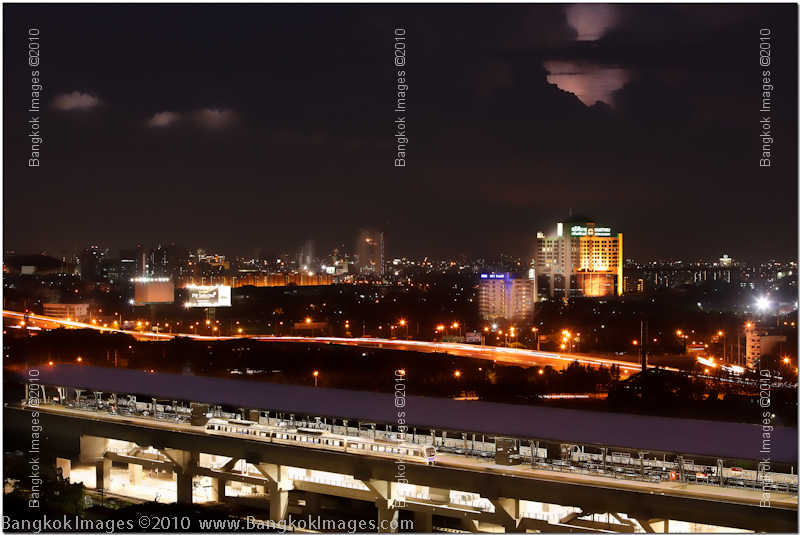
Canon 5d Mark II, 70-200mm F2.8L IS @F8 1.6secs 73mm ISO 800
This is as close as I came to the composition I had in my mind. You can see 'some' lightning showing behind the clouds, the Expressway lights streaming together, the skytrain in the station properly
exposed, and the cityscape properly exposed. If you include the lightning, building lights, train lights, car lights, station lights, street lights, and other misc lights you can see there was a heck of a lot of balancing exposure wise. With 3-4
heavy bolts of lighting I would have been pleased. With 3-4 heavy bolts of lighting and showing the effects of 'speed' like I did above I would have been ecstatic.
Summary
You can see the progression from the ordinary to the fun and almost.. almost to the dramatic scene I envisioned. All within an hours time from the same location.
The lesson here is that being a 'camera technician' is fine, it's an absolutely necessary skill towards a great composition. Even with the camera on automatic we could have captured the first
four images. But this student is well on his way to much better compositions precisely because he can control the camera. The next few stages of his growth is applying that control to the scene around him.
Our feet never moved, same location, same equipment, an hours difference in time. But several remarkably different compositions. By taking the time to study the scene and determine what we wanted our composition to be, we were able to enhance the final
image tenfold. It doesn't begin and end with a standard exposure.. Any camera in Automatic mode can do that. It only starts with a standard exposure. It never ends. The possibilities are infinite.
Photography News of Interest *menu
The top names in tripods has been Gitzo on the upper end and Manfrotto on the more reasonably priced end of consumer tripods. Really Right Stuff is a company who spares no expense when
it comes to their products and I own many of them myself, from L-brackets for your DSLRs, lens feet, ball heads, and now they claim to have made the ultimate tripod legs. They're carbon fiber and on examination do seem to be top flight. If
you're in the market for a hefty set of legs that may be the best there are.. then give these a try. Rumor has it that several different size versions will
be announced soon.

No matter how many expensive DSLRs with the latest bells and whistles are announced, the market cries out for a simple well executed and inexpensive compact zoom we can carry on vacation or during travels for snapshot quality images. Digital Photography review has done just that with its review of "travel zooms", small compacts with a 35mm equivalent focal length ranging from 24mm to 392mm. That's a heck of a lot of lens! DPR tests 13 of the most popular in this category in one test report. Lots of comparisons.

For some this may seem obscene. $5500,00 USD's on a camera? Yes. Those professionals working in studios and professional landscape photographers desiring the very best image quality often spend much more than this. Many professions on a job are carrying 3-4 digital MF cameras, more digital backs, and scores of lenses necessary to take the very highest quality image of a certain scene. Who do you think is taking Nikon and
Canon's wonderful pictures of their latest DSLRs?

If your Japanese is okay you can read this article and learn Olympus earned a Japanese invention award for the technology behind their dust removal systems. Much of this type of technology we now take for granted, but many of us can remember fighting with dust on our sensors every time we went out to shoot. Now these types of systems make dust issues rare.

Death of a Canon DSLR.
A food blogger had his shutter seize right in the middle of photographing sticky buns. I liked this article for its background and candid look at why he chooses and justifies the cost of his gear. Very practical.

To sell a luxury apartment. Real estate photography is big business and creates the 'first impression' of a property for potential buyers. Getting it right the first time is essential. Real estate photographers often 'build' their
images after the fact adding light and adding/subtracting items in the room. Read this article to learn more about this profession. David Paler is one such professional.

The Canon 70-200mm F2.8L IS II is the most recently 70-200mm lens on the market and so far all reports and reviews have been very favorable. SLRgear.com has just postedthis review. If you're interested in such a lens you'll want to read this review.

Readers Submissions *menu
BkkSteve –
These are some images from my recent outings I'd like to share.
KVW








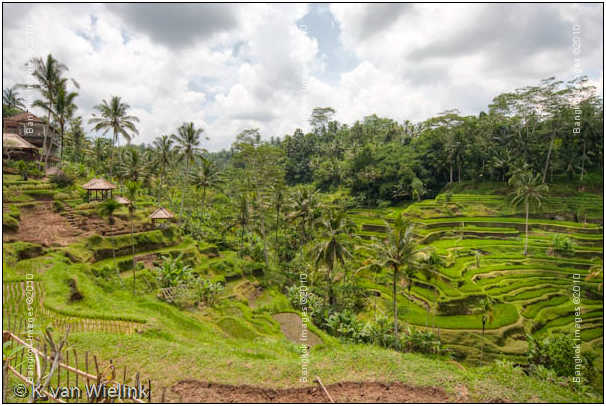
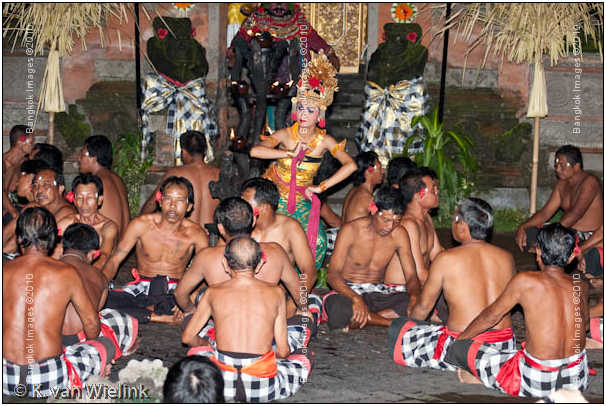
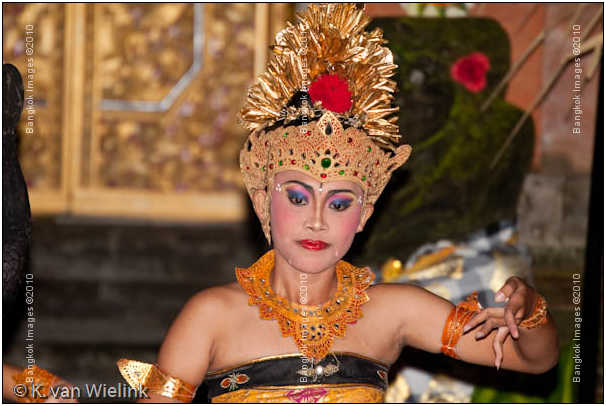
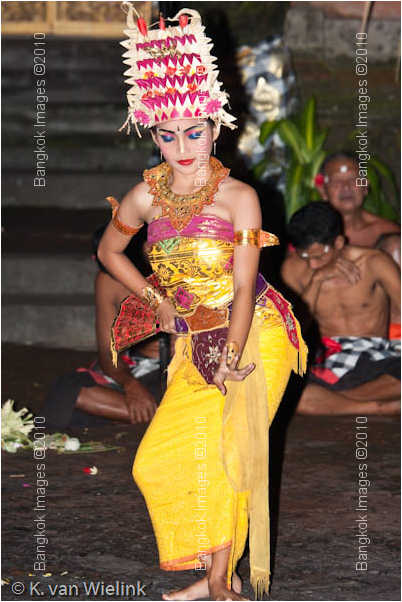
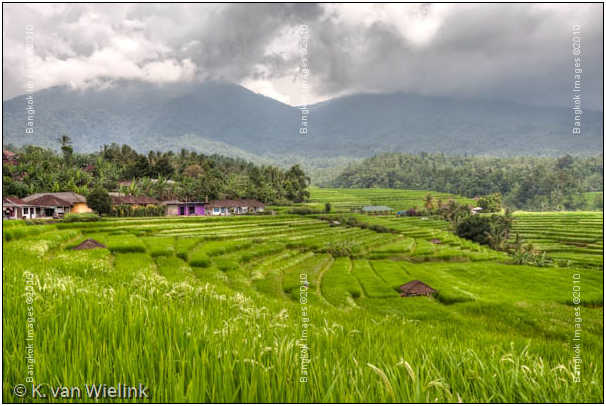
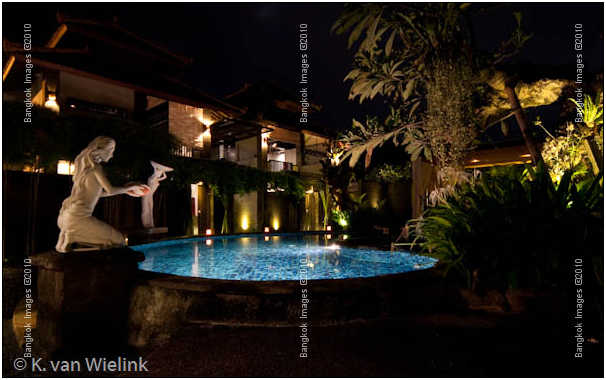
KVW –
These are very nice! It's obvious you're improving at a fast rate since out initial time together. I'm really looking forward to more. Thank you!
Steve
I suspect the readers submissions will be a highly anticipated section of this column and I encourage anyone with photographs and travel accounts they'd like to share to please send them to me at: info@BangkokImages.com
Readers Questions *menu
CANON POWER SHOT S90 VS SONY NEX-5
Steve:
I see you have and are now using the new Sony NEX-5 that you ordered a few weeks ago. The pictures in this week's column taken with the Sony sure look clean and sharp.
Rick – This is a great question and one which involves several areas so I'm going to answer it paragraph by paragraph. Read on please.
As you may recall acting upon your advice in Nov of last year, I purchased the Canon S90 and it is a fine camera and meets my needs except in two areas. The 4x optical zoom is very limiting in shooting telephoto pictures and the video 640 x 720 does not give the great results.
Keep in mind that ANY modern digital camera has compromises and selecting one is often simply a matter of deciding which compromises you can live with and/or afford.
With that said I can understand how the S90's 4x zoom could sometimes be limiting and for sure the video on most any point and shoot class camera is less than desirable.
My questions revolve around how much better is the Sony NEX-5A with the DSLR (Exmor™ APS HD CMOS sensor (23.4 X 15.6mm)), and the video AVCHD: 1920 x 1080/ 60i than the S90. In your opinion, would it be worth upgrading (for $700) to the Sony NEX-5?
The APC-S sized sensor is used in 95% of the DSLRs on the market. It would be an understatement to say you'll see a dramatic difference in low light capability when using higher ISO's and overall image acuity. Whether or not its worth a certain
dollar amount is a question only you can answer. But indeed, there is a huge difference in the resulting files.
If I read the NEX-5A specs correctly, it does not have an optical telephoto capability built in. The option would be to purchase the NEX-5K with a different lens. Is this correct or am I missing something?
The Sony NEX-5 series cameras are all 'detachable lens' cameras, which means there are no optical features "built in." You will buy this camera with either the 14-55mm or 16mm kit lens. Each has its advantages.
Sony will soon make available a longer telephoto and of course as this is a brand new mount they'll be releasing new lenses in the future.
Would the picture quality in low light situations show big improvement over of the same pictures taken with the Canon S90?
In ANY low light capture exposure is key, properly captured you'll see huge differences between the two cameras.. but in the order of 2-3 stops.. don't expect miracles.. only significant improvement.
Would/do you find the need to attach the flash a real incontinence when shooting in different environments like a birthday party etc.?
You mean inconvenience? 🙂 Yes, sometimes the requirement for flash is inconvenient but with the Sony NEX-5 you'll find it more of an option. It's low light high ISO performance will allow you to take available light pictures in these circumstances,
or you can activate the included flash and shoot higher quality lower ISO images. Flash, used properly, can dramatically enhance a image. Unfortunately it's most often not used properly and they have that heavy "flash look" which
is undesirable.
With that said, I've found the included tiny flash for the Sony NEX-5 totally unobtrusive, easily left on all the time and 'flipped up' into the ready position when needed.. and its "fill" capabilities for events
in smaller rooms are quite good. I'm very pleased with the automatic fill from this combination.
My use of any camera is for personal pleasure only. I just enjoy taking many pictures, then returning home and editing out 70-80% of the shots.
What you use the camera for isn't as deciding as you might think. I know many guys who have gear far exceeding my own and it's all for personal pleasure. One just purchased a $55,000 MF digital camera and over $80,000 worth of extra lenses and
accessories. It's for his pleasure too.. but he gets more pleasure with higher quality images.. 🙂
Note:
I recently purchased the wife a Sony DSC-HX5BV and it really produces great quality photos. It has the 10x optical Zoom and AVCHD: 1920 x 1080 (59.94i, Interlace) video capability. It is a nice point and shoot and she makes good use of it during our travels.
I would ask you to check it out as you offered in this week's column but it would require me flying from Walnut Creek to BKK. NOT. 555
LOL! What better reason than to make a fun run to Bangkok? I'll expect you early next week.. 🙂
Take care Rick I suspect you'll really enjoy the Sony.. but keep in mind there is no perfect camera out there. It's all merely a matter of degrees..
Steve
Thanks in advance for any information, advice, or help in understanding the Sony NEX-5 better.
Rick
Please submit your questions to info@BangkokImages.com All questions will be answered and most will show up in the weekly column.
A Snapshot of Bangkok Images Week in Review *menu

This is a slower laid back week. My son is in town until the end of July so things will run at a more relaxed pace giving me more time to spend with him. We're planning some nice outings both inside and outside Thailand and I think that will be nice
and result in some good material for the column.
We continue to use and test our new Sony NEX-5 and this 7 ounce APC-S camera is really impressing us. There are several pieces of hardware being reviewed, NEC monitors, NEX-5 camera, Gigabyte GA-X58A-UD7 motherboard, HTC Desire smartphone, Western Digital
2tb Green hard drives, Intel x40g SSD, and more. Its a matter of a triage of sorts, which product ranks with the most important and which fits into our review schedule.
The Gallery of the Week belongs to Charles and has a good representation of his ongoing work with HDR images and some of his travels. Check it out here.
Dana submitted his latest Thailand Photo Story and you can read his latest "It All Counts" here. They seem to be very popular. The funniest thing happened, I forgot where Dana's stories were and by accident I typed into my browser www.ThailandPhotoStories.com and guess what happened?
A sign of things to come? Do you have your own Thailand Photo Story, amusing anecdote, or even a trip blog with pictures? Send it to me at info@bangkokimages.com and I'll get it put up for everyone
to share.
Infocus Blog, I'm Troubled *menu
Last week in a photographers forum I responded to a reader's posted images of India which mainly showed centered individuals in the frames and little else. My response to the post was:
I'm starting to develop what may turn into a troubling attitude about such things. I've lived in Asia most of my adult life, over 23+ years to date. I've been most everywhere from the ship breaking yards in India to the long necked villages
of northern Thailand. It is indeed good to enrich one's life with more knowledge and to experience more of the world.
The troubled attitude: When I first glanced at your thumbnails and like most images I see of the region I feel a bit offended. When we go to the zoo we photograph the great apes and tigers and lemurs and show them because they are unusual, different..
so we photograph them in their cages and gawk at the images. I'm offended when we do this with people no matter how different their culture is from ours. These are humans and if the most we can come up with that makes them interesting is
their difference in looks then I feel offended.
IMO.. it's not enough to show the common pictures we see of these people that only show their differences in appearance. Tour bus loads of tourists do that. We have a greater responsibility to these places we visit. With animals I greatly prefer
photographing them running and playing or tracking their next meal.. the natural things they do in the course of being 'wild animals' which encompasses more than their appearance. An eagle flying or catching a fish or
fighting in mid-air does justice to the eagle. A picture showing only an eagle.. does nothing.

One small girl stands out from her peers with eyes you'll never forget
We need to show these people interacting, living, laughing, suffering.. and bring in much more than a centered picture of someone who looks different than us.
I understand the depth of my time in Asia has led me to think differently than my fellow westerners about many things.. and perhaps its over the top to actually feel offended about such pictures. It just seemed an appropriate time to vent..
I think this works better if our expectations are realistic. I do a fair amount of work for NGO's in the area and I've taken on much on my own. I know I won't change the world or even a country.. but I have changed the lives of individuals
and once even a small village.
Images invoke emotion, and emotion plays on our impulses. Giving is most often impulsive. The better the work the more zeros on the check. That's the business aspect of this sort of work.

Looking out from the wire of the Mae La Refugee Camp. His life stops at this wire.
The personal toll can be much different. Its difficult to return 'home' knowing people are still living in these conditions, and the personal contacts you make.. the little girl who needed medical
care, the smart student wanting to study medicine, or the long food lines at the refugee camps.. the images don't easily go away. And I won't let them go away.

As you can see from the two prosthetic legs, land mines and booby traps continue to be an issue along the Burma border
I sometimes take interested individuals inside Mae La or to visit the orphanages adjacent to the main camps. Its best described as a "life experience", something that will forever change the way
you interpret life. No matter how good the images, and believe me I'm done my best to make the most compelling images possible.. nothing prepares you for the real thing. Its no longer only visual, but you now have the sounds and smell and
the touch of the little girls hand as she held yours during your tour of the camp.

A Karen 'teen' cares for her child as she carries it through the rain inside Mae La camp
One such evening along the Moei Me River we sat on the Thai side with the children around us with this look in their eyes that could only come from our listening to the mortars and machine gun fire rattling on the other side of this small river.. as they
understood it was their families and relatives being eradicated. A small fire surrounded by 30-40 pairs of the most foreboding eyes you've ever seen.
to far too many people it's about having that vacation picture of "different looking" people.. To a few of us it's about much more. I wish I was capable of explaining this better.. or
why 'zoo' pictures of the locals offend me.. I can only encourage you to come see for yourself. It's not the $50,000 Leaf camera that's making a difference.. someone who can 'see' will be more effective with charcoal and a sketchpad..

Young Karen Orphans
There is always one person: This person claimed to speak for 'all' the other forum members who were offended by MY attitude. He told me he thought I was better
than everyone else and this offended him.
You might assume he was one of the 'zoo picture' photographers, steps off a tour bus, snaps all the "natives" and continues on so when he returns
home he can show the folks what the natives look like and that he was there experiencing Asia right along with them. Perhaps. I really don't know. Maybe his feeling of being offended was justified. I'll let you guys be the judge on this
one.
However the outcome, I won't be changing my mind. When we photograph people simply because they look different than us, and those people tend to be very underprivileged third world victims of starvation, genocide, or even natural disasters.. then
I feel we're serving ourselves and not the people. This offends me because they have so little. It offends me because it doesn't take much thought or effort to photograph them in such a way so viewers will see their true world and possibly
find a way to help. They are people, not animals..
Until next time..



